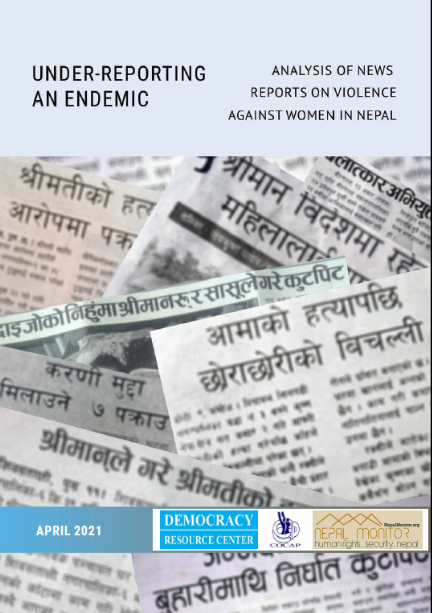Incident Reports
Everything you should know about the Nirmala Pant rape and murder case
2019-07-29
Nepal
The rape and murder of 13-year-old Nirmala Pant of Kanchanpur on July 26 last year became a flashpoint for Nepalis from across the country as the grisly rape and murder encapsulated just how unsafe Nepal is for women. The ensuing police investigation only furthered the outrage, with numerous gross incompetencies on the part of the police in what many saw as attempts to cover up for the perpetrators.
Nation-wide protests followed, with activists and the public demanding that the government and the investigating agencies ensure that the perpetrators be found and held to account. Around a dozen different investigative teams were formed, including two high-level teams under Home Ministry joint-secretary Hari Prasad Mainali and Additional Inspector General Dhiru Basnyat, but a year later, the case remains unsolved.
What is the Nirmala rape and murder case?
It was around 11am on July 26, 2018 when Nirmala Pant got on her bicycle to go to her friend Roshani Bam’s house in order to complete her homework. Pant, a grade nine student at the Saraswati Secondary School, was a resident of Bhimdutta Municipality in Kanchanpur. Pant never came back home.
The next day, on July 27, Pant’s body was found in a sugarcane field more than a kilometre from her home, around 600 metres from Bam’s home. Pant had been raped and subsequently murdered.
Immediately after the body was discovered, a series of negligent behaviours from the police came to light, including in looking for Pant the day she went missing. Protests began in Kanchanpur and spread across the country with the public demanding action against the police officers for their negligence and the arrest of the perpetrator/s.
How were the police negligent?
A high-level probe committee formed under Additional Inspector General Dhiru Basnyat accused Inspector Jagadish Prasad Bhatta of choosing to drink beer instead of searching for Pant when her parents cried out to him for help on the night of July 26.
When the body was discovered and the police reached the crime scene, police officers first on the scene engaged in unethical and suspect behaviour, which eventually resulted in strict departmental action. A recorded video of the crime scene, which went viral on social media, showed a police officer washing Pant’s trousers and covering the body.
Basnyat’s report, a copy of which was seen by the Post, implicates the duty officers for not following standard procedure, including employing police dogs. The police did not take proper care of enough evidence, as Pant’s trousers were left in the vehicle used to transport her body to the hospital. Scenes of Crime Officers (SOCO), who are specially trained to collect evidence from the crime scene, also failed to discharge their duties well and weren’t directed properly by senior officers. They also failed to maintain the ‘chain of custody’, which documents the chronological sequence of the custody of physical evidence, dispatching the vaginal swab two days after collecting it. Senior police officers were late, with the then chief of Kanchanpur Police, Superintendent of Police Dilli Raj Bista, visiting the crime scene only four days after the incident.
Along with neglect at the crime scene, police have also been accused of trying to frame 41-year-old Dilip Singh Bista, who had previously served a nine-year jail sentence for murdering his brother-in-law.
Nirmal's father Yagyaraj and mother Durga Devi. File Photo/TKP
Why was Dilip Singh Bista accused by the police?
On August 20, Kanchanpur District Police Office had presented Bista as the primary accused in Pant’s rape and murder. However, locals refused to accept Bista as the culprit and demanded his release, accusing the police of framing him. After a week, Bista was sent to Kathmandu for a medical examination. Police were subsequently forced to release Bista as his DNA did not match the sample collected from Pant’s vaginal swab.
Despite the DNA test, investigating officers are not ready to acknowledge Bista’s innocence. Police claim that Bista confessed to the crime multiple times under interrogation. In multiple interrogation videos obtained by the Post, Bista accepts the charges and even describes the manner in which he committed the crime. According to senior police officers, Bista’s descriptions match the nature of the crime.
If Bista confessed, why didn’t his DNA match the sample collected from the victim?
According to a report by the National Human Rights Commission, there were serious lapses in DNA collection, due to which a correct result could not be obtained. The DNA sample was collected into a test tube from three layers of a vaginal swab. But the commission report says that the extraction provided an insufficient sample of the DNA, which could also have been damaged. The report also found flaws in the scientific method applied to the DNA test.
Are there other major suspects?
The Central Investigation Bureau, in December last year, arrested Pradip Rawal, Pant’s neighbour, from Kathmandu. Rawal’s friend, Bishal Chaudhary, was also called to the bureau from Kanchanpur for interrogation. According to police sources, both Inspector General of Police Sarbendra Khanal and chief of the bureau Deputy Inspector General Niraj Bahadur Shahi personally interrogated both Rawal and Chaudhary.
Rawal and Chaudhary both confessed to Pant’s rape and murder under interrogation by Khanal, said police. After the confession surfaced in the media, Defence Minister Ishwor Pokhrel proclaimed that the culprits had been arrested.
However, neither Rawal nor Chaudhary’s DNA matched the sample collected from Pant’s vaginal swab, after which they were both released.
The duo has since accused the police of torturing them during interrogation, a charge police have denied.
How did protests demanding justice for Pant expand across the country?
Kanchanpur locals had started protesting the day Pant’s body was found. The protests intensified after police were accused of tampering with evidence and arresting Bista.
During protests demanding Bista’s release, in Kanchanpur on August 24, police fired live ammunition into the air to disperse the crowd. A teenager, 17-year-old Sunny Khuna, was killed, while 20-year-old Arjun Bhandara was injured by a bullet. Bhandara remains barely conscious at the Tribhuvan University Teaching Hospital.
This led to the escalation of protests across the country, demanding the arrest of perpetrators. A nationwide protest demanding #JusticeForNirmala took central stage. However, protests have died down since the autumn festive season.
Protestors take part in a rally demanding Justice for Nirmala in December, 2018. Sanjog Manandhar/TKP
What has been the government’s response towards the protests?
Protests have been obstructed time and again by police officers and the government with posters demanding justice torn down and people arrested for putting them up. Police arrested campaigners from Maitighar Mandala in Kathmandu on November 30, on the grounds that VVIPs needed safe passage during the ongoing Asia-Pacific summit. Similar arrests and tearing of posters were later marked across the country in which police officers cited orders from higher authorities.
While the posters were being torn down by police citing orders from higher authorities, Minister for Communication and Information Gokul Prasad Baskota in November last year personally summoned the editors of all five state-run media—Rastriya Samachar Samiti, Gorkhapatra, Rising Nepal, Radio Nepal and Nepal Television—and directed them not to publish any critical news related to Pant’s rape and murder.
What would be the way forward in the case?
Along with testing DNA samples from Dilip Singh Bista, Rawal and Chaudhary, police have also tested the DNA samples from SP Bista; Kiran Bista, SP Bista’s son; and Ayush Bista, nephew of Bhimdutta Municipality Mayor Surendra Bista. However, none of the DNA samples matched the sample collected from the victim.
According to senior police officers who were directly and indirectly involved in the investigation, there is little chance of finding the perpetrator by focusing on DNA. However, officers believe that investigating and interrogating major suspects by focusing on circumstantial evidence can be the way forward.
In the Godamchaur rape case of November 2017, the perpetrators, who were arrested after being identified by the victim, were released by the Lalitpur District Court citing lack of evidence. Similarly, the DNA of the perpetrators—Raghu Silwal, Pawan Kunwar and Bishal Dhwaj Karki—also did not match with the sample collected from the victim.
However, around a month after the release order, the Patan High Court overturned the decision and ordered the authorities to arrest the trio again. After their arrest, the Lalitpur District Court, on March 1, sentenced all three of them to 10 years in jail based on the victim’s statement even after the DNA did not match.
Where does the Nirmala Pant rape and murder case stand now?
It has been a year since the incident but the police are nowhere close to identifying and arresting the perpetrators. The government and police officials continue to vow that a serious investigation into the case is ongoing, but there has been little to show.
On July 23, Home Minister Ram Bahadur Thapa, during a press conference at the Home Ministry, said that the government held firm on arresting the perpetrators, but also flippantly remarked that rape was commonplace in Nepal and that Pant’s rape and murder had been “unnecessarily politicized”.
Although the Nepal Police has a solid record of solving cases, there are numerous problems with the way police handle rape cases.
***
What do you think?
Dear reader, we’d like to hear from you. We regularly publish letters to the editor on contemporary issues or direct responses to something the Post has recently published. Please send your letters to tkpoped@kmg.com.np with "Letter to the Editor" in the subject line. Please include your name, location, and a contact address so one of our editors can reach out to you.
Correction:
The perpetrators of the Godamchaur rape case were released before the DNA report was submitted, citing the lack of evidence against them. An earlier version of this article said the three men were released after the DNA report had come out.
Related Reports
GBV / Siraha
Complaint lodged against a 30-year-old man on the charge of raping a 13-year-old teenage girl in Siraha
GBV / Okhaldhunga
52-year-old man arrested on the charge of sexually assaulting a 16-year-old teen girl in Okhaldhunga
GBV / Humla
Teen boy arrested on the charge of raping a 40-year-old woman in Humla
GBV / Rupandehi
Complaint lodged against a 22-year-old youth on the charge of raping a minor girl in Rupandehi
GBV / Bhaktapur
25-year-old man arrested on the charge of harassing girl over social media
Related Trend Analysis
Analysis

THE NEPAL PEACE MONITOR ANNUAL REVIEW: 2020
October 25, 2021
Human Trafficking / LGBT+ Rights / GBV / Political / Children’s Rights / Senior Citizens’ Rights / HRD Issues / Human Rights / Interpersonal Violence / Governance / Covid-19 / Civic-Space / PwD
Analysis

COCAP BIWEEKLY: INCIDENTS SURROUNDING COVID-19 MARCH 1 - 15, 2021
March 25, 2021
GBV / Governance / Covid-19
_001.png)




